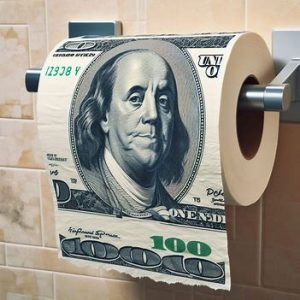
By Richard Morey
February 7, 2024
 What is a Debt Trap?
What is a Debt Trap?
For many years I have pooh-poohed the notion the United States deficit would push us into what is called a ‘debt trap.’ This is when the size of a country’s deficits are so large that the interest payments overwhelm the ability to continue without massive, currency-destroying increases in even more public debt. At that point, you either stop borrowing – plunging the economy into a severe recession – or you continue and borrow your way into hyper-inflation and currency debasement.
These are, obviously, both terrible outcomes, yet at this point the idea we may be facing a debt trap is becoming more plausible. Last year, I misjudged how government spending would continue to explode. Two-thirds of all economic growth last year was due to an increase in government debt. I never thought we would see a day – outside an official recession or world war – when our yearly deficit would be $1.8 trillion. This was an increase in total debt – in one year – equaling 6% of GDP. This was $365 billion more than the massive deficit of the previous year. Going into debt $365 billion in one year would be imprudent, yet that is the amount of the increase!
With the government now rolling over trillions of dollars of debt this year at today’s much higher rates, that number will continue to increase dramatically. When do interest payments begin to “crowd out” productive spending in the economy such that growth becomes impossible?
When you combine government and personal debt increases last year, it took $2.50 to produce $1 of economic growth. Can you say ‘unsustainable?’ (The funny thing about something unsustainable is that it will, without fail, stop.) As regular readers will remember, early in 2023 I proclaimed the Republicans in the House of Representatives would surely squelch any new government spending. However, it turns out the Inflation Reduction Act and the Chips Act, which were passed in the previous Congress, went into effect last year. I had expected this money to dribble into the economy over a period of years; instead it came flooding into the economy last year.
Most of this government spending went into building new manufacturing plants for green energy projects. These subsidies were huge, leading to a 60% increase in spending on factories last year. This growth should not be confused with growth in manufacturing itself, which did not expand last year and has now been contracting for over a year and a half.
Once in a debt trap, the only way out often appears to be – a lot more debt. “Down that path lies ruin,” in this case the purchasing power of one’s currency. This is why it’s called a trap, i.e. if you stop increasing the debt the economy goes into reverse, but if you keep adding more debt the end result is demonstrably worse.
I have no prediction on how our government debt situation will unfold. For the first time, however, I’m forced to watch the U.S. Government debt levels for a risk I hoped we’d never see.
At the same time, I still expect Treasury bonds through which the deficit is covered to outperform – perhaps substantially – one more time. But if Congress and the Fed once again respond to the next recession with trillions of dollars of new debt, while tax revenues are collapsing, I would be on alert for a potentially severe drop in our currency’s value. This means that, at Secure Retirement, we would be scouring the investment universe to find those few assets which would fully protect our clients from a true currency crisis. (Spoiler Alert: You might end up owning a whole lot of gold & silver. You will, without doubt, end up overweight in the one asset class that stands above all others when it comes to investing in currencies, i.e. managed futures.)
Last Year’s Economic Scorecard
We’re led to believe these days that the Fed has and will be able to steer us through these rough economic waters without falling into recession. In fact, the soft landing crowd, i.e. no recession but continued, albeit slow, growth, seems to have won the day as 2024 begins.
 As I’m sure our readers expect by now, I believe the recession has been postponed but not canceled. Yes, it is, once again, taking longer than anticipated. And once again the reason for the delay is called more debt. In this case, not only on the part of the government but the other biggest spenders – consumers.
As I’m sure our readers expect by now, I believe the recession has been postponed but not canceled. Yes, it is, once again, taking longer than anticipated. And once again the reason for the delay is called more debt. In this case, not only on the part of the government but the other biggest spenders – consumers.
Last year I did not expect credit card balances to mushroom nearly 10%. The savings rate continued to fall, now well below where it was before the pandemic. So consumers spent their savings, are maxing out their credit cards, and ended the year turning to “buy now/pay later” schemes. I hope to be forgiven for guessing consumers writ large would curtail their spending before draining the last bit of credit available to them. Silly me.
When you add the excess government spending with booming consumer debt, GDP supposedly grew at a 3.3% annualized rate in Q4. However, one respected analyst (David Rosenberg) called this mainly a “weather report,” as the number would have been a paltry 1.6% had we not had the warmest December since 1921.
Employment
I believe the realization we’re in a recession will hinge on one factor called jobs. Last year we heard, each and every month, that the employment picture is strong. This would be true if we only looked at the one number that is announced each month. This number comes from something called the ‘Payroll Survey,’ and it purports to show how many new jobs were created the previous month. It doesn’t – not even close.
The Payroll Survey has too many flaws to explain here, but the bottom line is that many if not all the new jobs it finds are nothing but completely unverified guesses. Quite often every single new job was conjured up out of thin air.
 Instead of looking at the employment picture through such a flawed lens, the other measure of new jobs, the ‘Household Survey,’ does not include any fictional categories of non-verifiable new jobs. What did it show about employment last year?
Instead of looking at the employment picture through such a flawed lens, the other measure of new jobs, the ‘Household Survey,’ does not include any fictional categories of non-verifiable new jobs. What did it show about employment last year?
In the last 6 months of the year, not one new job was added in the United States. But it gets worse. During the last half of the year, we lost 1.6 million full-time jobs which were replaced by part-time. In fact, all you really have to do to see the weakness in the labor market is to look at the number of part-time jobs being created versus full-time jobs being lost. The Payroll Survey blindly counts a person who took another part-time job to make ends meet as if another unemployed person is finally back to work. (They could easily take this blindfold off, as they have the data.)
The Household Survey, on the other hand, simply asks people if they already had another job before getting the new part-time gig. Those who say ‘yes’ aren’t counted as if they were previously unemployed.
By now, most readers are surely wondering why such obvious mistakes are made each month. Of course, I’m sure you immediately know the answer. The employment numbers are an exercise in politics. Unlike most political topics, this is one which enjoys consistent bipartisan support. Whether the President is a Republican or Democrat, every Administration wants to show us they’re doing a great job creating new jobs, so nobody wants numbers that aren’t being manipulated.
Yes, it really is just that simple, and I don’t blame the government for putting out biased jobs reports. What I dislike is the fact the media doesn’t report the numbers from the Household Survey (which is equally ‘offical’), nor do they discuss the differences between full and part-time employment.
As an aside, these employment reports may help explain the discrepancy between the fact the people view the economy as weak when the big economic numbers (GDP + employment) remain positive.
employment reports may help explain the discrepancy between the fact the people view the economy as weak when the big economic numbers (GDP + employment) remain positive.
As of December, 30 states saw their unemployment rate rise one-half of one percent or more. This is a fairly good indicator those states are already in contraction, i.e. recession. Additionally, further research shows companies have been hoarding full-time workers. Coming out of the pandemic, we had labor shortages in many industries. Companies therefore have been loathe to let these people go, yet that is exactly what many are planning to do this year. In January we heard company after company announce layoffs.
What Happens Next?
There is a good reason we focus on employment to try to see how the economy is likely to perform this year. As we’ve seen, the economy is being held up by debt spending. The government is unlikely to see another spike in spending without new legislation being passed. Since new spending bills will be hard to come by this year, this leaves only one source available to lead the economy higher – consumer spending.
Those paying attention will point to potential business spending as the preferred way to grow any economy. Unfortunately, all the surveys of business executives/owners show they aren’t inclined to spend any extra money right now. Business lending has continued to fall for many months while expense-cutting is happening throughout the corporate sector. Again, this just leaves consumer spending to keep the economy out of recession.
economy out of recession.
We have now learned that US consumers will spend until there is nothing left in their checking account and nobody will lend them any more money. One thing will, however, change this equation. I was wrong last year in thinking people would curtail spending when it was going on credit cards charging 20% interest – but they will stop when their feeling of job security diminishes. This is why we spend so much time studying the employment reports.
Conclusion
Since January 1, at least 776 companies have announced mass layoffs. Unless this reverses fairly soon, consumers will pull back their spending and we’ll have the long-awaited recession.
Unfortunately for the vast majority of investors, concerns about recession – which were quite high during the first half of 2023 – have now been cast aside. This means they are positioned for continued growth. It also means they are positioned for severe losses when the missing recession turns up in the next few weeks, months or – at the outset – quarters.
